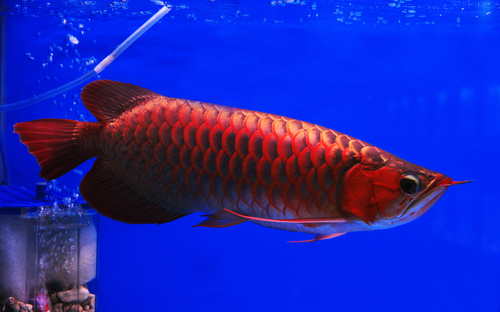Also called Dragon Fish, Arowanas are unique fish with unusual prehistoric features. With large, iridescent scales, a sinuous body, dark-colored barbels, and a bony tongue, Arowanas grow up to 48 inches, so you’ll need to keep them and their tank mates in a large aquarium.
Arowanas aren’t aggressive and tend to ignore other species in a community tank if they are well-fed and have adequate space.
The best Arowana tank mates include passive and semi-aggressive species like the Firemouth Cichlid, Green Terror Cichlid, Clown Loach, Knife Fish, Pacu Fish, and schooling fish like Silver Dollar Fish.
The key thing is to ensure that the species aren’t aggressive and relatively the same size to prevent larger fish from eating the smaller ones. The species listed are compatible and get along well in a community tank.
Discover the top 15 kinds of fish best suited to share a tank with your Arowana.
Contents
The 15 Best Arowana Tank Mates
Check out these other similar posts:
1. Oscar Fish
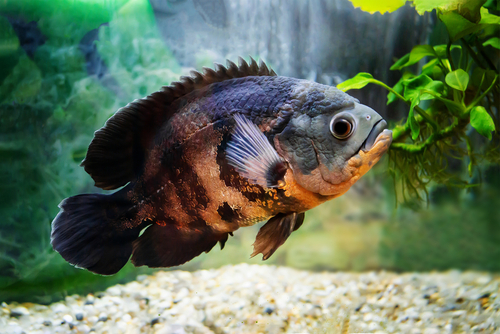
- Scientific name: Astronotus ocellatus
- Origin: Amazon and Orinoco River Basins, French Guiana, and northern Paraguay
- Size: Up to 10 inches in a tank
- Care level: Moderately difficult
One of the best fish that’s safe to keep with Arowanas is the Oscar Fish. While some kinds of cichlids are too aggressive to live in a community tank, there are several kinds of more mellow-tempered cichlids that play well with larger, mildly aggressive fish.
The Oscar Fish meets both requirements for life in a community tank since it is calm and grows from 12-16 inches long. These traits enable the Oscar Fish to hold its own in a community tank.
Oscars tend to be messy fish and require a high-protein diet. You’ll need a heater in your Oscar Fish tank to keep temperatures a tropical 74-81 °F degrees. You will also need to refresh 10-15% of the water in the tank each week to keep the water clean and well-maintained.
Pros of keeping with Arowana
- Smart, trainable, and compatible with other large fish species.
Cons of keeping with Arowana
- Has high nutritional needs and produces a lot of waste.
2. Flying Fox Fish
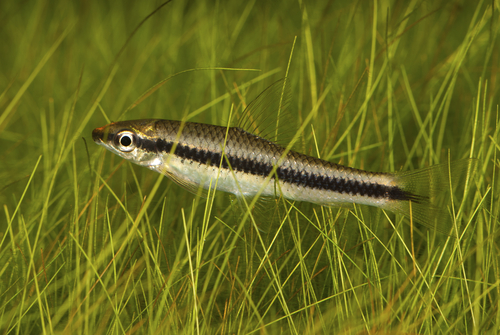
- Scientific name: Epalzeorhynochos kalopterus
- Origin: Borneo, Java, Malaysia, Sumatra, and southern Thailand.
- Size: 4.7 up to 6 inches
- Care level: Intermediate
With dramatic orange and black stripes on an iridescent, pale golden body, the Flying Fox Fish is an interesting species to add to any community tank. It’s part of the Cyprinidae fish family that originates in Thailand, Java, Sumatra, and Malaysia.
These fish grow up to 6 inches in a tank, live for about eight years, and make good tank mates for Arowana.
Just make sure to provide a 100-gallon tank to offer the Flying Fox Fish enough space to swim. It’s also best to create a gravel or sand substrate and add rocks, pebbles, plants, roots, or driftwood to simulate a riverbed environment. Keep temperatures in a range between 68-78 °F and feed the Flying Fox Fish with a live and frozen diet, vegetables, and algae wafers.
Pros of keeping with Arowana
- Excellent algae eaters
Cons of keeping with Arowana
- Aggressive and territorial with fish that look similar to their species. This does not include the Kuhli Loach.
3. Tiger Datnoid
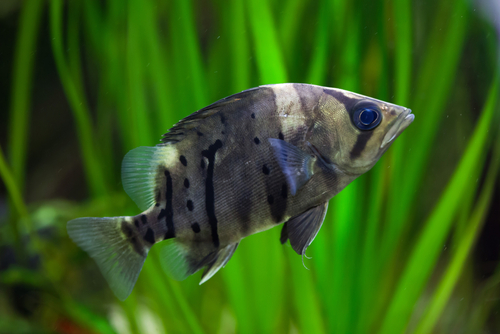
- Scientific name: Datnioides microlepis
- Origin: Indonesia, New Guinea, and Southeast Asia
- Size: 9 to 12 inches and from 14 to 15 inches in some species
- Care level: Moderate
Also called a Tiger Fish due to the multiple stripes that cross its gold and white body, Tiger Datnoid fish hunt for small fish, shrimps, crabs, snails, and crustaceans in the wild. In a community tank environment, this carnivorous fish needs a variety of live food, but can also adapt to frozen food and food pellets.
These large fish can grow up to 18 inches in a tank. Since they are also shy and won’t bother Arowanas, they will spend a lot of time hiding in rocks and caves provided in the aquarium.
Pros of keeping with Arowana
- Generally peaceful
Cons of keeping with Arowana
- Susceptible to Ich or White Spot Disease, fin rot, and eye problems.
4. Blood Parrot Fish

- Scientific name: Scaridae
- Origin: Taiwan
- Size: 6 to 8 inches
- Care level: Intermediate
If you’ve ever raised cichlids before, it’s easy to take care of a Blood Parrot Fish. These bright orange fish often have small white patches and can grow up to 8 inches long.
These fish have a calm temperament, but they are active swimmers and enjoy exploring their aquarium. They also startle easily and dart away if they feel threatened, so it’s important to provide a lot of plants, rocks, and hiding places in the tank so that they can feel safe.
Pros of keeping with Arowana
- Non-aggressive
Cons of keeping with Arowana
- None
5. Knife Fish

- Scientific name: Apteronotidae
- Origin: Cambodia, Laos, Vietnam, and Thailand
- Size: 8 to 10 inches
- Care level: Intermediate
With a dramatic body that is shaped like a blade, this large fish originates in Africa, South America, Central America, and Southeast Asia. The Knife Fish has a unique, backward swimming ability that makes it an interesting tank mate.
The largest species, the African Knife Fish, can grow anywhere from 8-12 inches long. Due to their size, the biggest Knife Fish will need tanks as gigantic as 200 gallons. It’s a good idea to use artificial plants in aquariums that contain Knife Fish since they are active swimmers that tend to uproot live plants.
Pros of keeping with Arowana
- Generally peaceful in a community tank with other large and non-aggressive fish.
Cons of keeping with Arowana
- None
6. Pacu Fish
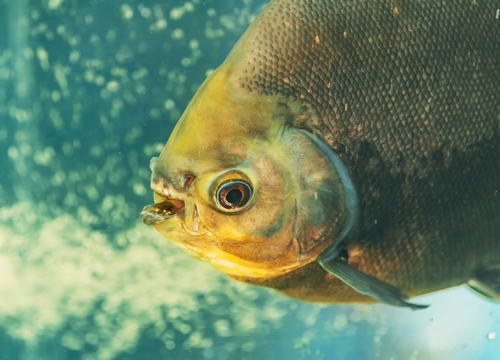
- Scientific name: Colossoma macropomum
- Origin: Tropical and subtropical areas in South America
- Size: May reach 3 feet long
- Care level: Intermediate
These tetra and piranha cousins hail from South America and some species can grow from 6 inches to more than two feet. While young Pacu fish engage in schooling behavior, they turn solitary as adults. Mature Pacu fish make good Arowana tank mates since they prefer being left alone.
Keep in mind that while the Pacu isn’t usually aggressive, they tend to nibble at other fish’s fins, so it’s not a good idea to house them in the same tank with fish that have beautiful or long fins. Like other Arowana-compatible tank mate species, these fish need temperatures that hover between 76-82 ° F, so your tank should have a good heater to create the proper environment.
Pros of keeping with Arowana
- Non-aggressive
Cons of keeping with Arowana
- Requires a large tank
7. Iridescent Shark
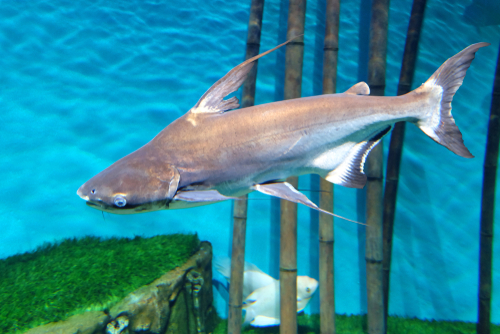
- Scientific name: Pangasianodon hypophthalmus
- Origin: The Chao Phraya and Mekong Rivers in Asia
- Size: Over 4 feet long
- Care level: Expert
Like its name, this bottom-feeding fish has shiny gray skills and long mouth barbels that they use for navigating the substrate. Despite its shark-like name, the Iridescent Shark belongs to the catfish family in a species that is close to the Mekong Giant catfish.
Since the Iridescent Shark spends most of its time swimming around the tank’s middle water column, it won’t bother the Arowana which likes to float and feed in the upper water column.
This fish needs a massive 300-gallon tank since it can reach up to four feet long. It’s also important to leave the middle water column area open and free of plants or other obstructions to allow the fish to swim freely. Make sure to use a soft substrate that won’t damage their delicate barbels.
Pros of keeping with Arowana
- Non-aggressive
Cons of keeping with Arowana
- Large size that requires a lot of tank space.
8. Silver Dollar Fish
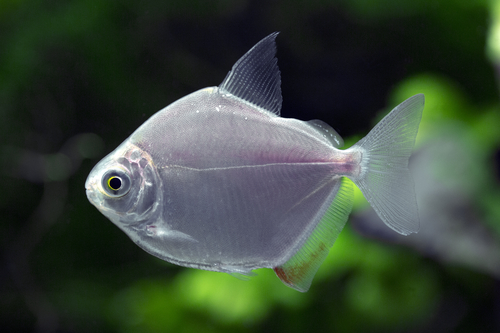
- Scientific name: Metynnis argenteus
- Origin: South America
- Size: 6 inches
- Care level: Intermediate
These six-inch silvery fish are popular aquatic pets due to their shiny silver bodies that flicker like coins in the water. As schooling fish, Silver Dollar Fish are a peaceful bunch and need a small school of fellow Silver Dollar Fish and plenty of tank space to thrive.
On the plus side, these fish are easy to care for and are perfect Arowana companions. On the downside, they are active fish that create a lot of waste, which means your tank will need an intricate filtration system to maintain tank health and cleanliness.
Pros of keeping with Arowana
- Calm, hardy, and active schooling fish
Cons of keeping with Arowana
- Require large 75-gallon tank
9. Clown Loach
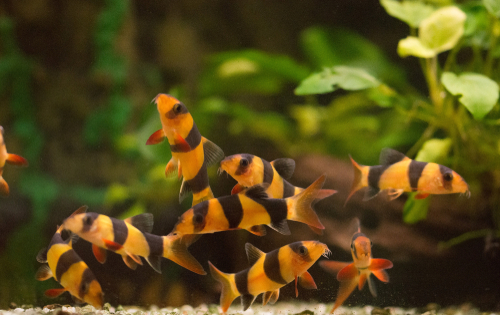
- Scientific name: Chromobotia macracanthus
- Origin: Borneo and Sumatra
- Size: 6 to 8 inches.
- Care level: Intermediate
These peaceful bottom dwellers prefer the lower substrate where they won’t get in an Arowana’s way. They have broad black bands on their golden body and orange tips on their graceful front fins and tails.
Since they are a schooling species, they love to spend time with at least four other companions while exploring large aquariums. It’s best to add sturdy plants, driftwood, rocks, and caverns in the aquarium so that Clown Loaches have a lot of places to hide.
Pros of keeping with Arowana
- Peaceful
Cons of keeping with Arowana
- None
10. Firemouth Cichlid

- Scientific name: Thorichthys meeki
- Origin: Mexico, Belize, Yucatan Peninsula, and Guatemala
- Size: 5 to 6 inches
- Care level: Easy
One of the best Arowana tank mates is the Firemouth Cichlid. These striking fish have blue eyes and electric blue, orange, and gray bodies, and fins.
While it has a generally peaceful nature, this cichlid can get territorial defending its favorite spots of vegetation or rock and wood caves in the middle water column and lower substrate from other fish. These form monogamous pairs, while males can get territorial if others get close to juvenile Firemouth Cichlids.
These fish have similar tropical temperature needs as the Arowana, so tank temperatures should range from 75 to 86 °F. They will generally leave Arowanas alone since they prefer the lower parts of the tank and are often seen busily digging up and moving plants or shifting ornaments around the tank.
Pros of keeping with Arowana
- Peaceful and don’t need a lot of space.
Cons of keeping with Arowana
- Sensitive to water parameters.
11. Texas Cichlid
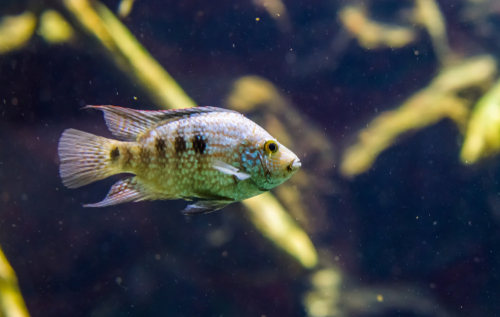
- Scientific name: Herichthys cyanoguttatus
- Origin: Southern Texas and northern New Mexico
- Size: 12 inches
- Care level: Intermediate
A sparkly pearly gray body with blue or greenish-colored scales has also earned the Texas Cichlid the name of Pearl Cichlid. In the wild, this species can grow to nearly a foot long, while it will stay a smaller size when raised in aquariums.
It’s important to know that Texas Cichlids can get aggressive with smaller fish that they view as prey, so it’s best to keep them with big fish such as Arowanas. Like the Firemouth Cichlid, this fish enjoys pulling up plants and rearranging rocks, ornaments, or driftwood in the tank. Add a fine gravel or sand substrate in a 125-gallon tank that has an excellent filtration system.
Pros of keeping with Arowana
- Generally peaceful schooling fish if kept in a school.
Cons of keeping with Arowana
- Need a large tank to prevent territorial issues
12. Green Terror Cichlid
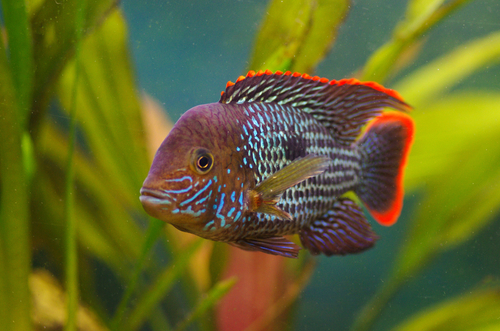
- Scientific name: Andinoacara rivulatus
- Origin: Peru and Ecuador
- Size: 12 inches
- Care level: Easy
This gorgeous cichlid comes from America and is most closely related to the Blue Acara fish. One of the best ways to enjoy the fish’s iridescent colors is to use different LED lights and watch their bodies change from blue green to pale-green shades.
With bodies that measure up to 12 inches long, these fish have an enormous bio-load. This means that adults need a tank with a minimum of 100 gallons and a canister filter system.
The Green Terror Cichlid got its name because it can turn aggressive in a crowded or substandard environment and terrorize smaller fish in the area. Since the Arowana are also large fish, the Green Terror Cichlid gets on well with Arowanas when housed in a proper habitat.
Pros of keeping with Arowana
- Generally non-aggressive fish
Cons of keeping with Arowana
- May act aggressive towards smaller, docile fish or towards other males of the same species.
13. Jack Dempsey Cichlid
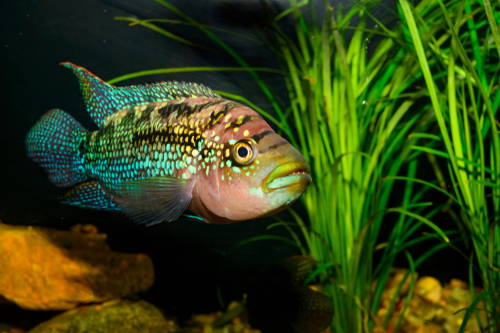
- Scientific name: Rocio octofasciata
- Origin: Central America
- Size: Up to 8 inches
- Care level: Intermediate
This pugilistic fish will add some spice to your community tank with its aggressive personality and shifting shades of gold, pink, and blue scales. The Jack Dempsey Cichlid has a combative reputation, but this is typically only a problem if the tank is filled with smaller fish or males engage in territorial battles when other fish invade its space.
If you’re an experienced aquarist, the Jack Dempsey is a good choice for an Arowana tank mate for several reasons.
These fish prefer the lower and middle tank areas, which means that their space doesn’t conflict with Arowanas who prefer the upper water column stream. They are attractive fish that reach 10-15 inches long.
They also like hiding in rocks, caves, and crevices, enjoy a sandy substrate and don’t uproot live plants. Just make sure that you provide a tank that holds at least 80 gallons for the best living conditions.
Pros of keeping with Arowana
- Hardy and interesting.
Cons of keeping with Arowana
- Need a 100-gallon tank for a pair of Jack Dempsey Cichlids to avoid aggressive and territorial behavior
14. Tinfoil Barb
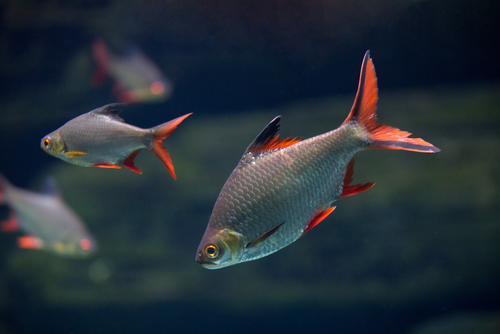
- Scientific name: Barbonymus schwanenfeldii
- Origin: Borneo, Sumatra, Malaysia, and Thailand
- Size: May grow to 14 inches long
- Care level: Easy
Native to Southeast Asia, the Tinfoil Barb inhabits large rivers and lower coastal areas in the wild. In an aquarium, this fish can grow up to 14 inches and can live for 8-10 years.
If you’re looking for a colorful tank mate, the Tinfoil Barb has a silver body that fades to a golden gradient. Fins and tails are a striking red color.
Even better, this calm fish is an undemanding pet if it has a large enough tank. You’ll want to add a stony substrate pebbled with smooth stones to create the perfect Tinfoil Barb habitat that mimics a riverbed.
Pros of keeping with Arowana
- Peaceful temperament
Cons of keeping with Arowana
- None
15. Florida Peacock Bass
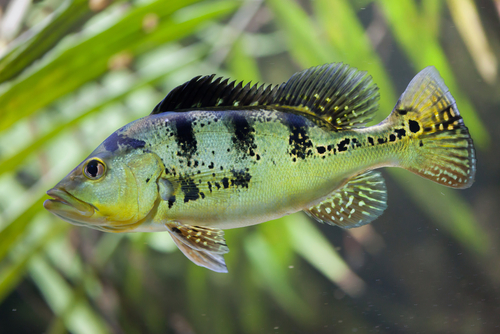
- Scientific name: Cichla ocellaris
- Origin: Florida and the Amazon River
- Size: 12 to 17 inches
- Care level: Moderate
While the Peacock Bass is an intimidating predator in the wild, where it hunts small fish and vulnerable species such as the Spotted Tilapia, these voracious feeders are content tank mates in an aquarium so long as you feed them well.
For example, juvenile Peacock Bass float waiting for food and require small doses of live or frozen food a couple of times per day. Adults get by just fine with one or two big meals every day. Since Peacock Bass can grow up to 18 inches long, you’ll need a large aquarium to keep them from getting territorial.
Pros of keeping with Arowana
- Generally non-aggressive
Cons of keeping with Arowana
- None
Final Thoughts
In general, the best kinds of fish to keep with Arowanas in a community tank are larger fish that are slightly aggressive. That’s because these fish can get Arowana to back off and aren’t small enough to fall prey to their tank mates.
Keep in mind that all fish are different, so you’ll want to start by adding compatible fish slowly and watching how they get along.
The best kinds of Arowana tank mates are larger bottom feeders or middle-tank-dwellers that prefer to spend their time away from the Arowanas’ favorite feeding spot near the upper water column. By getting compatible fish that don’t fight each other for food or space, you’ll help ensure that everyone gets along in the community tank.

Ian Sterling, founder of Fishlab.com, began his aquarium journey over 30 years ago, driven by a deep fascination for fish and their diverse personalities. His website, Fishlab.com, is dedicated to making fishkeeping accessible and enjoyable, offering beginner-friendly guidance, expert insights, and a community for aquarists to connect and share experiences.


